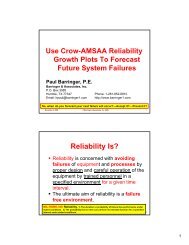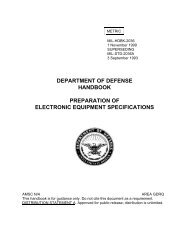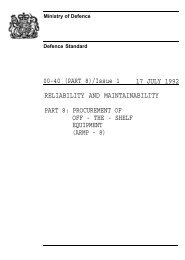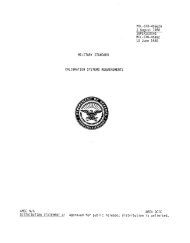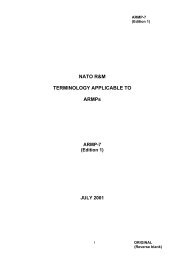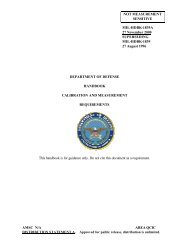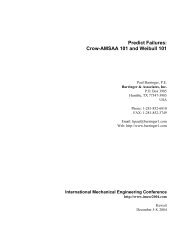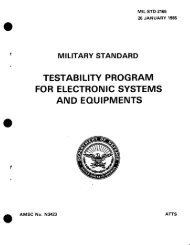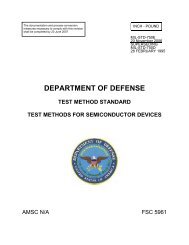MIL-STD-1629-RevA - Barringer and Associates, Inc.
MIL-STD-1629-RevA - Barringer and Associates, Inc.
MIL-STD-1629-RevA - Barringer and Associates, Inc.
Create successful ePaper yourself
Turn your PDF publications into a flip-book with our unique Google optimized e-Paper software.
MTl,-STl)-lii?(l ATASK 101FAILURE MODE AND EFFECTS ANALYSIS1. Purpose. The purpose of the FMEA is to study the resultsor effects of item failure on system operation <strong>and</strong>,to classify eachpotential failure ~ccording to its severity.2. Documents referenced in Task 101:SPECIFI CATIONSMilitarvSTANDARDSHIL-M-24100 Manual, Technical, Functionally Oriented MaintenanceManuals (FOMM) for Equipment <strong>and</strong> SystemsMilitary<strong>MIL</strong>-<strong>STD</strong>-756 Reliability Prediction<strong>MIL</strong>-<strong>STD</strong>-78Cl lkfinitions of item Levels, item Exchangeability,Models <strong>and</strong> Related Terms:3. Analysis approach. Variations in design complexity <strong>and</strong>available data will generally dictate the analysis approach to be used.There are two primary approaches for accomplishing an FMEA. One is thehardware approach which lists individual hardware items <strong>and</strong> analyzestheir possible failure modes. The other is the functional approachwhich recognizes that every item is designed to perform a number offunctions that can be classified as outputs. The outputs are listed <strong>and</strong>their failure modes analyzed. For complex systems, a combination of thefunctional <strong>and</strong> hardware approaches may be considered. Tile FMEA may beperformed as a hardware analysis, a functional analysis, or a combinationanalysis <strong>and</strong> may be initiated at either the highest indenture level <strong>and</strong>proceed through decreasing indenture levels (top-down approach) or atthe part or assembly level <strong>and</strong> proceed t}]rougllincreasing indenturelevels (bottom-up approach) until the FMEA for the system is complete.3.1 Hardware approach. The hardware approach is normallyused when hardware items can be uniquely identified from schematics,drawings, <strong>and</strong> other engineering <strong>and</strong> design data. The hardware approachis normally u~ilized in a part level up fashion (boLtom-up approacl~);however, it can be initiated at i~ny lC!VC1 of indenture <strong>and</strong> progress ineither direction. Eat}) identified f,~ilurt-mode shall be assigned aseverity classification wl]ich will be utilizud during design LO establishpriori~ies for corrective actions. *‘-)1*,,



